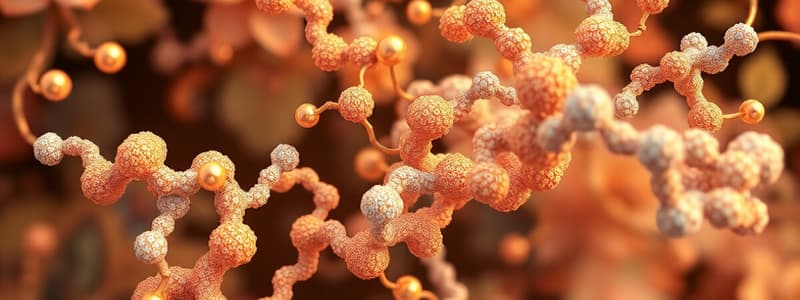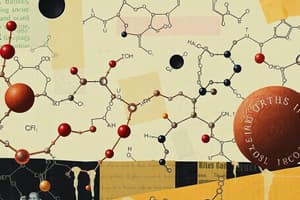Podcast
Questions and Answers
What is the fundamental difference between peptides and proteins?
What is the fundamental difference between peptides and proteins?
Peptides are smaller chains of amino acids, whereas proteins are larger macromolecules composed of one or more polypeptide chains.
Describe the role of the R group in amino acids.
Describe the role of the R group in amino acids.
The R group determines the unique properties of each amino acid, influencing its polarity, charge, and hydrophobic or hydrophilic nature.
Explain how a peptide bond is formed.
Explain how a peptide bond is formed.
A peptide bond is formed through a dehydration reaction, where a water molecule is removed, linking the amino group of one amino acid to the carboxyl group of another.
What is meant by the primary structure of a protein?
What is meant by the primary structure of a protein?
Identify the types of interactions that stabilize tertiary protein structure.
Identify the types of interactions that stabilize tertiary protein structure.
What are some functions of proteins within biological systems?
What are some functions of proteins within biological systems?
Define denaturation and its impact on protein function.
Define denaturation and its impact on protein function.
What is the significance of quaternary structure in proteins?
What is the significance of quaternary structure in proteins?
What is denaturation, and what factors can lead to it?
What is denaturation, and what factors can lead to it?
How do peptides differ from proteins in structure and function?
How do peptides differ from proteins in structure and function?
What techniques are commonly used for protein and peptide analysis, and why are they important?
What techniques are commonly used for protein and peptide analysis, and why are they important?
Describe the importance of protein folding and the consequences of incorrect folding.
Describe the importance of protein folding and the consequences of incorrect folding.
What are post-translational modifications and their potential impact on proteins?
What are post-translational modifications and their potential impact on proteins?
What role do protein-protein interactions play in cellular functions?
What role do protein-protein interactions play in cellular functions?
What is meant by the hydrophobic effect in protein folding?
What is meant by the hydrophobic effect in protein folding?
Explain the significance of amino acid sequence in determining the function of peptides.
Explain the significance of amino acid sequence in determining the function of peptides.
Flashcards
Proteins
Proteins
Large, complex molecules essential for life, composed of chains of amino acids linked by peptide bonds.
Amino Acids
Amino Acids
The building blocks of proteins, containing a central carbon atom bonded to an amino group, a carboxyl group, a hydrogen atom, and a variable side chain.
Peptide Bond
Peptide Bond
A chemical bond formed between two amino acids, linking them together in a polypeptide chain.
Primary Structure
Primary Structure
Signup and view all the flashcards
Secondary Structure
Secondary Structure
Signup and view all the flashcards
Tertiary Structure
Tertiary Structure
Signup and view all the flashcards
Quaternary Structure
Quaternary Structure
Signup and view all the flashcards
Protein Denaturation
Protein Denaturation
Signup and view all the flashcards
Protein Folding
Protein Folding
Signup and view all the flashcards
Post-Translational Modifications
Post-Translational Modifications
Signup and view all the flashcards
Protein-Protein Interactions
Protein-Protein Interactions
Signup and view all the flashcards
Denaturation
Denaturation
Signup and view all the flashcards
Peptides
Peptides
Signup and view all the flashcards
Protein and Peptide Analysis
Protein and Peptide Analysis
Signup and view all the flashcards
Factors causing Denaturation
Factors causing Denaturation
Signup and view all the flashcards
Misfolding
Misfolding
Signup and view all the flashcards
Study Notes
Introduction to Peptides and Proteins
- Peptides and proteins are essential biological macromolecules composed of amino acid chains.
- These chains are linked by peptide bonds, forming a linear structure.
- Proteins have diverse functions, including catalysis, transport, and structural support.
- Peptides are smaller chains of amino acids, often with specific biological functions.
Amino Acids
- Amino acids are the building blocks of peptides and proteins.
- Each amino acid has a central carbon atom (alpha carbon) bonded to an amino group (-NH2), a carboxyl group (-COOH), a hydrogen atom, and a variable side chain (R group).
- The R group determines the unique properties of each amino acid, influencing its polarity, charge, and hydrophobic or hydrophilic nature.
- Twenty standard amino acids are commonly found in proteins.
- Some amino acids are essential, meaning the body cannot synthesize them and must be obtained from the diet.
Peptide Bonds
- Peptide bonds link amino acids together to form a polypeptide chain.
- The peptide bond is formed through a dehydration reaction, where a water molecule is removed.
- The peptide bond is a partial double bond, contributing to the rigidity and planar nature of the bond.
- The peptide bond exhibits resonance, which influences its properties and the overall structure of the polypeptide chain.
Protein Structure
- Protein structure is crucial for function.
- Primary structure: The linear sequence of amino acids in the polypeptide chain.
- Secondary structure: Localized folding patterns stabilized by hydrogen bonds between backbone amide and carbonyl groups, e.g., alpha-helices and beta-sheets.
- Tertiary structure: The overall three-dimensional shape of the polypeptide chain, stabilized by interactions between R groups (e.g., hydrophobic interactions, disulfide bonds, ionic bonds).
- Quaternary structure: The arrangement of multiple polypeptide chains (subunits) in a protein complex.
Protein Function
- Proteins perform a vast array of functions within cells and organisms.
- Enzymes catalyze biochemical reactions.
- Transport proteins carry molecules across membranes or throughout the body.
- Structural proteins provide support and strength, e.g., collagen, keratin.
- Regulatory proteins control gene expression and cellular processes.
Protein Denaturation
- Denaturation is the loss of a protein's native structure, leading to a loss of function.
- Denaturation can be caused by various factors, including changes in temperature, pH, or the presence of chemicals.
- The unfolding of the protein structure disrupts its specific interactions, and hence, its biological function.
Peptides
- Peptides are shorter chains of amino acids than proteins.
- They typically have specific biological functions depending on their amino acid sequence.
- Examples include hormones, neurotransmitters, and antibiotics.
- Many peptides are involved in signaling pathways, regulation of cellular activities, and interactions between cells.
Importance of Protein and Peptide Analysis
- Techniques like chromatography and electrophoresis are used to separate and analyze proteins and peptides.
- Mass spectrometry is used to determine the amino acid sequence and the overall molecular weight.
- These analyses are essential for understanding protein function, disease mechanisms, and development of new therapies.
Protein Folding
- The process by which a polypeptide chain folds into a specific three-dimensional conformation, determined by the amino acid sequence.
- This folding is driven by various non-covalent interactions and the hydrophobic effect.
- Correct folding is essential for the protein's correct function.
- Incorrect folding can lead to disease.
Post-Translational Modifications
- These modifications occur after a protein is synthesized and can impact its structure and function.
- Examples include phosphorylation, glycosylation, and ubiquitination.
- These modifications can alter the protein's activity, stability, localization, or interaction with other molecules.
Protein-Protein Interactions
- Proteins often interact with other proteins to carry out complex biological processes.
- These interactions can be transient or stable and are crucial for many cellular functions.
- Specific regions on proteins, known as binding domains, mediate these interactions.
- Disruptions in protein-protein interactions can contribute to various diseases.
Studying That Suits You
Use AI to generate personalized quizzes and flashcards to suit your learning preferences.




